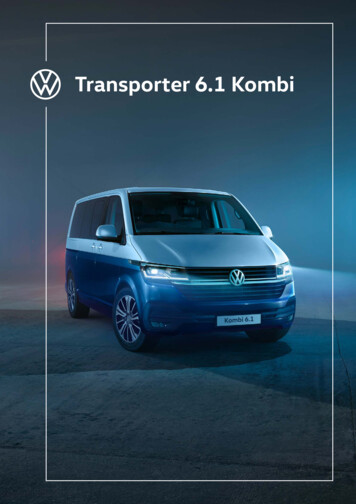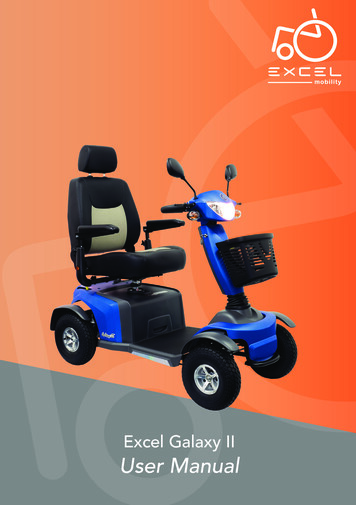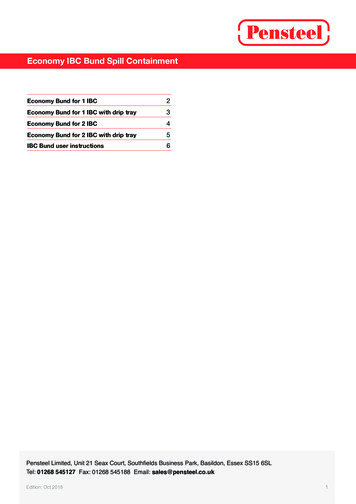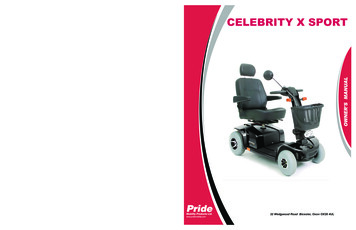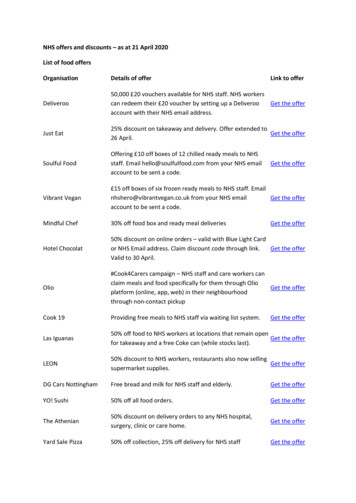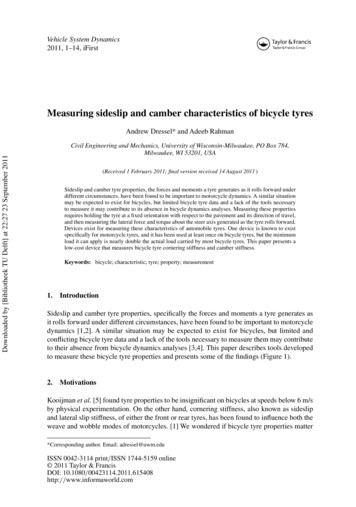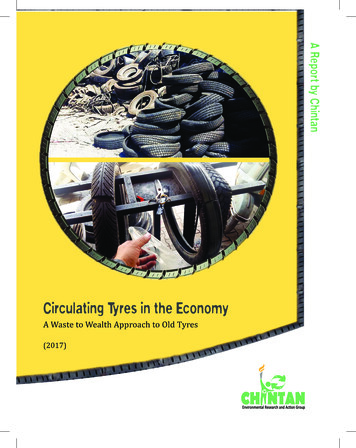
Transcription
A Report by ChintanCirculating Tyres in the EconomyA Waste to Wealth Approach to Old Tyres(2017)
Published byChintan Environmental Research and Action GroupC14, Second Floor, Lajpat Nagar III, New Delhi 110024Phone: 91-11-46574171 or 46574172Email: info@chintan-india.orgWebsite: http://www.chintan-india.org/Facebook: https://fb.me/ChintanIndia.orgTwitter: https://twitter.com/ChintanIndiaInstagram: https://www.instagram.com/chintan.india/About Chintan Environmental Research and Action GroupChintan is a registered non-profit organization with a vision of inclusive,sustainable, and equitable growth for all. Our mission is to reduceecological footprints and increase environmental justice throughchanges brought about through partnerships, capacity building at thegrassroots, advocacy and research, and sustainable, scalable models onthe ground.AuthorsBharati Chaturvedi (Chintan)Rajat Rai Handa (Chintan)AcknowledgementsChintan would like to thank the following people for their valuablecontribution in writing this report: Darpan Anil Singh, Lalit Sharma,Madhu Jagdeeshan, Richa Chaturvedi, Shaila Faleiro and Taruni Kumar.We would also like to thank the dedicated team at Chintan who helpedwith various aspects of the research and fieldwork: Chitra Mukherjeeand Imran Khan.Copyright notice Copyright 2017, Chintan Environmental Research and Action GroupPlease feel free to use the information here to promote environmental,economic and social justice. We urge you to quote this report when youuse the information in it and inform us if possible.
Over the last two decades, the world has seen an exponential rise in the number of motorvehicles. The World Health Organization (2015) notes that 53% of the motorized vehiclesare in middle-income countries and only 46% are in high-income countries. Currentprojections also indicate a further rise in these numbers, i.e. by 2040, the number of carsbeing produced will double.Closely related are the growth trends in the global tyre industry, which currentlymanufactures close to over a billion tyres. The tyre industry is the largest consumer ofnatural rubber and is estimated to be currently consuming close to 12 billion tonnes(WHO 2015) or two-thirds of the world’s production of natural rubber.Resource-heavy growth models have made it essential to prioritize issues of sustainablemanagement of natural resources and resource efficiency within the growth agenda. Theidea that current ‘waste’ is an untapped resource as a potential source for secondary rawmaterials is core to this discussion. Across the world, it is this lens of ‘waste as preciousresource’ that influences the approach to the issue of End-of-Life Vehicles (ELVs), i.e.,scrapped, thrown and disposed of vehicles, as waste. ELVs are treated as a source forrecycled steel, aluminium, plastics, rubber and copper. Tyres are just one componentin ELVs, yet owing to their composition, they have a complete self-sustaining economyaround them. Universally, tyres are made of high quality rubber and are considered alarge potential source of raw material for the rubber industry. How large that potentialis can be understood by noting that in the financial year of 2016-17, an estimated 127.4million tyres were produced (Tinna Rubbers 2017).Circulating Tyres in the Economy: A Waste to Wealth Approach to Old Tyres Executive SummaryExecutive SummaryGlobally, dumping and stockpiling of tyres has been the most common practice ofdisposal. The last couple of decades have seen various governments, as well as tyremanufacturers, becoming conscious of the environmental issues and the loss of resourcesinvolved in the dumping and burning of tyres. This growing concern has translated1
Circulating Tyres in the Economy: A Waste to Wealth Approach to Old Tyres Executive Summaryinto concerted political action wherein several countries have chosen to explore variedsystems and models towards the management of End-of-Life Tyres (ELTs).This report attempts to capture these salient policies and practices of reuse and recycleof ELTs that are being undertaken across both India and globally, while also exploring,in detail, the best possible alternative currently available to India for safe end-of-lifehandling practices for tyres.The first section provides insight into the scale of the problem of ELTs at both theglobal and the national level. This section also attempts to provide an overview of thecurrent systems of recycling that are prevalent in the country. Given that there is notmuch direct documentation on the scale and pattern of recycling in the informal sector,the section draws extensively from Chintan’s on-ground study and experience, whichfocuses on the informal sector of tyre recycling in North India. The section also providesan overview of recycling in the formal sector of ELTs with an introduction to the Indianreclaim rubber industry. This industry comprises of only 60 odd manufacturers of which6-7 manufacturers like Balaji Group, KK Reclamations, Tinna Rubbers, GRP, KohinoorRubbers etc. serve as leaders.The recycle and reuse of a tyre, especially in the informal sector, depends on its condition.The second section focuses on understanding the current practices of reuse and recycleof ELTs in the country. These practices can be broadly distinguished as being productreuse (retreading/regrooving and mechanical modification) and material reuse (pyrolysisand combustion). Retreading and regrooving are the most direct and cost-effectivereuse of old tyres. They do not require too much specialization and ensure significantutilization of the resource, i.e., old tyres. When tyres-as-a-whole cannot be reused, theyare manually shredded to obtain secondary materials– tread, bead and side walls. Insome cases, large chunks of rubber are used to create items of low value.With a further grinding of the shredded parts of the tyre, ‘rubber crumb’ is obtained,which is of greater value. Rubber crumb or crumb rubber serves as raw material in theproduction of many items such as specific moulded goods such as floor mats, rubbersheets, hose pipes and battery containers. Rubber crumb also serves as the base rawmaterial for the reclaim rubber industry.ELTs also play an important role in providing energy directly as Tyre Derived Fuel (TDF)and indirectly as Tyre Pyrolysis Oil (TPO). At times, ELTs are decomposed, primarily forenergy and additionally for their component parts. Pyrolysis is used to reprocess tyresinto fuel gas, oils, solid residue (char) and low-grade carbon black. We did not find thiswidely practiced. ELTs and scraps of rubber, which are easily available, also serve as acost-effective fuel or energy source and are often used in brick kilns, in sugarcane jaggerymanufacture (in North India) and as a source of heat in winter. This last use is also highlypolluting.2
The fourth section elaborates the systems being developed globally to ensure thetyres follow a circular economy pathway. The first part of the section focuses onunderstanding the systems in ELT management in the European Union (EU), whichhas been a pioneer in the field. At 96%, the EU has the highest rate of recycling of ELTscurrently (ETRMA 2011). This has been made possible due to the conscious alignmentof the respective member states’ policies to their ELT management schemes. Across theEU, there are 3 main models of managing ELTs: the extended producer responsibility, freemarket model and the government responsibility (tax system) model. At present, acrossthe EU, irrespective of the model being followed, there is a push to explore innovativerecycling options which take maximum advantage of the various qualities of rubber. Thefocus of recycling and reuse of tyres has been in the fields of housing, roads and railwaysthrough the development of applications for reclaimed rubber – as rubber fillers, CrumbRubber Modified Bitumen (CRMB) and rubberized cement and for recovered textile.The fifth section of the report focuses on understanding India’s ELT management system.India currently does not have a centralized ELT management policy. It treats ELTs as‘hazardous waste’ and the policies that broadly apply to this category are also applicableto ELTs. But, understanding the magnitude of the concern, the country has also tried tostreamline the process of ELT management through a series of specific guidelines andrules. In the current draft guidelines of the Waste Tyres Management Rules 2017, thegovernment has attempted to introduce ELT management through an extended producerresponsibility approach. But this attempt has not been very well received by all parts ofthe industry and still stands as a draft, which is pending final approval. This section alsoexplores the Indian position and policies on recycling of ELTs and scrap rubber with aspecific focus on policies related to crumb rubber, reclaimed rubber and Tyre PyrolysisOil (TPO) processes. The last part of this section, explores, in detail, the advantage andpush at the national level by the Ministry of Road Transport and Highways towardsCRMB-based roads.Circulating Tyres in the Economy: A Waste to Wealth Approach to Old Tyres Executive SummaryDue to the non-biodegradability, flammability and chemical composition of tyres, whenthey’re not recycled, they pose enormous environmental problems. The third sectionprovides insight into the environmental problems related to the burning and stockpilingof tyres. Tyres, as material, can be extended post-consumption in a variety of other formsand it is important to understand this complex circular economy. This section also brieflyexplores the understanding of recycling and reuse in terms of this circular economy.To conclude, it is important as a country to ensure that tyres are not just used as fuel andthat other options of optimum resource efficiency are also explored. Due to the fall in theprices of crude oil, the market for TPO is limited and/or falling. The rubber reclaim sectorwithin the country is also currently limited but has much potential to grow. Tapping intothe CRMB market is one of the key ways forward. Though the initial construction costsof CRMB-based roads are noted to be 6.88% higher than bitumen-based roads, over the3
Circulating Tyres in the Economy: A Waste to Wealth Approach to Old Tyres Executive Summarylifetime of the road, i.e. 15 years, there are savings of over 28.74% or INR 6,59,224 perlane/per km. Also, the renewal period in the case of roads which are laid using CRMB isat 5-7 years as opposed to roads laid using bitumen which is within 3-5 years.Hence, in a growing economy like India with its growing volume of ELTs, there is a needto include CRMB as the alternative on scale, because while informal sector activitiesfor reuse are important, they alone will be unable to handle the projected deluge. Thiswill not only ensure optimum reuse and recycle of the raw materials involved but alsoreduce overall infrastructural costs and prevent pollution from open burning of tyreremains for fuel. To achieve this, there is a need to consciously increase the uptakeof CRMB from ELTs, whether it be for strengthening and repairing older roads andhighways or for building newer roads and highways. Alongside, the upgradation of theinformal sector is also important.This report concludes that adapting CRMB would serve as a concerted effort in linkingthe growing road infrastructure along with the increased motorization within thecountry. Thus, by ensuring that every kilometre of road is laid using CRMB, we areensuring that around 3,350 ELTs are recycled in an environmentally friendly manner.Moreover, by ensuring that the estimated 2,75,000 ELTs which are disposed eachday are converted to CRMB, as country we would be ensuring nearly 30,000 kms ofenvironmentally friendly roads each year. In this process, we are also additionallyensuring that optimum resource efficiency is achieved, while simultaneously improvingconnectivity and ensuring better infrastructural quality. Ultimately, with a country-widefocus on CRMB, we are ensuring that we subscribe to a more sustainable, controlled andresponsible development model.4
Executive Summary31.An Explosion in the Tyre Industry 102.1.1 Types of Tyres Manufactured1.2 Understanding the Scale of End-of-Life Tyres (ELTs)1214What is happening to Tyres in India? 172.12.22.32.4Tyre Recycling Trends in IndiaReuse of Old Tyres: Regrooving and RetreadingRegrooving TyresRetreading TyresMechanical Modification (As Rubber Crumbs or Shredded Rubber Pieces)Reuse of Products: Tread, Bead and Side WallsDecomposition: Thermo-Chemical and CombustionPyrolysis: Thermo-Chemical DecompositionTyres as Fuel (TDF)1720202122222323243.The Problem with Tyres 264.3.1 Environmental PollutionCirculating Tyres in the Economy: A Waste to Wealth Approach to Old Tyres Table of ContentsTable of Contents26What is the World Doing? 294.1Can We Create a Circular Economy of Tyres?EU Policy on ELT RecyclingExtended Producer ResponsibilityFree MarketGovernment ResponsibilityTransboundary Initiative: EU’s International Trade of ELTs3031323232335
Recycling Options of ELTs GloballyUse in RoadsUse in Athletic TracksUse in Rubberized CementUse of Recovered TextileUse in Rail TransportUse of Rubber to Reduce Noise PollutionInnovation from Other Parts of the World36373939404040405.15.2Draft Guidelines of the Waste Tyres Management Rules 2017Breach of ResponsibilityIndustry Response to the ActRecycling Options for ELTs in IndiaProduction of Crumb Rubber and Reclaimed RubberTyre Pyrolysis Oil (TPO)From Waste to Wealth: Crumb Rubber Modified Bitumen (CRMB)Cost Analysis Using Bitumen VG 30 v/s CRMB 6043444444444848516.16.2Upgrade the Way the Informal Sector WorksUse ELTs in roadsMinistry of Surface Road Transport and HighwaysMinistry of Environment, Forest and Climate ChangeRubber Skill Development CouncilState Road Transport Corporations535354545555Circulating Tyres in the Economy: A Waste to Wealth Approach to Old Tyres Table of Contents4.25.6.Indian Policy on ELT Recycling 42Conclusion 53Annexure 1: List of Tyre Hubs in North India 56References 58Bibliography 62List of Interviewees 65List of FiguresFigure 1: Motorization Rate of the WorldFigure 2: Cross Sections of Crossply Tyre and Radial TyreFigure 3: Timeline on Ban of Old VehiclesFigure 4: Structure of a TyreFigure 5: Circular Economy of TiresFigure 6: ELT Management Schemes in EuropeFigure 7: Non-Auto Tyre Rubber Sector (India)69121319282943
Photo 1: Pneumatic TyresPhoto 2: Manual Regrooving of Tyres at JaliKhoti Road, Kher Nagar, Meerut, UPPhoto 3: Manual Retreading of a Tyre in MeerutPhoto 4: Kohlu or Kalesar being operated to manually shred waste rubber for burningPhoto 5: A towering cloud of smoke rising from the Rhinehart tyre fire, Virginia 1983List of Boxes1218202326Box 1: Did You Know?Box 2: Different Types of Pneumatic TyresBox 3: Ban on Old Vehicles on the Road Means Even More TyresBox 4: What is Reclaimed Rubber?Box 5: Eco-Toxicity of Tyres: Some StudiesBox 6: International Commitment to Sustainable Management of Natural ResourcesBox 7: Regulation on Disposing of Tyres in Landfills: Some PerspectivesBox 8: Understanding REACHBox 9: Article 2.1: Exemptions from the Duty to RegisterBox 10: Sustainability Victoria: Tyres in AustraliaBox 11: Some Facts about the Global Use of Crumb Rubber Modified Bitumen (CRMB)Box 12: Clarion Call to Move to a Circular EconomyBox 13: Innovative Uses of ELTs: Some ExamplesBox 14: Understanding India’s Mat Export to the EUBox 15: Some Facts about the use of CRMB in Indian RoadwaysBox 16: Advantages of CRMB-based RoadsBox 17: Landmark Research Findings on CRMBList of Tables1011131725273132333435394445474849Table 1: Advantages of CRMB over BitumenTable 2: Initial Road Construction CostTable 3: Road Renewal Cost364950Circulating Tyres in the Economy: A Waste to Wealth Approach to Old Tyres Table of ContentsList of Photos7
1. An Explosion in the Tyre IndustryThe Indian economy, while mirroring the global trends of rising incomes, coupled withaspirational high consumer behaviour, is envisaged to grow at a rate of 5-6% GDPper annum. This means that the country is currently facing a higher rate of resourceconsumption along with an increasing rate of urbanization. McKinsey (2010) projectsthat the urban population in India will nearly double by 2030. The population in citieswould increase from the current 340 million to an estimated 590 million. Furthermore,cities that currently account for 58% of India’s GDP (2008) would, by 2030, accountfor nearly 70% of the country’s GDP (McKinsey Global Institute 2010). This effectivelymeans that 8 metropolises (Mumbai, Delhi, Kolkata, Chennai, Bangalore, Ahmedabad,Hyderabad, and Pune) will become home to more than 100 million inhabitants and willcome under severe pressure for resources.Steady but isolated growth in any sectors of the economy is insufficient to supportand maintain the projected growth. Innovation, especially in infrastructure related totransport, plays a vital role in ensuring the transformation of a growing economy intoa vibrant one. Rapid transport-related infrastructural growth means growth in theinfrastructure required to sustain these vehicles (in roadways, railways, airways andwaterways) coupled with growth, particularly in the automotive and aviation sector.India currently has the second largest road network in the world which comprises over54,72,144 km of roads (MoRTH 2016). 60% of all goods in the country and 85% of India’stotal passenger traffic depend on this network. To ensure the growth of the economy,there is a lot of stress on constructing and strengthening the highways and road networksfurther. Reflecting this trend, the total length of highways being constructed in a yearwas at an all-time high in FY 2016-17. At an average pace of 22.3 km per day, 8,142 km ofhighways were constructed during this period (IBEF 2017).8The rural road network has also seen a significant increase under the Pradhan MantriGram Sadak Yojana (PMGSY). The current construction in 2016-17 was 133 km of roads
In the long run, the government, under different programs such as the National HighwaysDevelopment Project (NHDP), Special Accelerated Road Development Programme inNorth East (SARDP-NE) and Left-Wing Extremism (LWE), plans to develop a total of66,117 km of roads. Additionally, part of the long-term goal of the National HighwayAuthority of India (NHAI) is to double the length of the national highway network. By2022, NHAI plans to build 50,000 km of roads worth approximately USD 250 Billion orINR17 Lakh Crores (PTI 2016).On the other side, the growth of the automotive sector cannot be underestimated. Basedon trends, it is projected that by 2020, India is expected to grow into the 3rd largestautomobile market in the world (PTI 2017). Moreover, the Indian automotive aftermarket i.e. the market for spare parts, accessories and components of motor vehicles,is estimated to grow at around 10-15 per cent to reach USD 16.5 billion by 2021 fromaround USD 7 billion in 2016. It also has the potential to generate up to USD 300 billionin annual revenue by 2026, create 65 million additional jobs and contribute over 12% toIndia’s GDP (IBEF 2017).Therefore, recycling and reuse of vehicles, which are currently not at the forefront ofthe growth discussion, will come to play a vital role in ensuring resource efficiency andsustainable development.Figure 1: Motorization Rate of the WorldCirculating Tyres in the Economy: A Waste to Wealth Approach to Old Tyres An Explosion in the Tyre Industryper day as opposed to the 73 km per day between 2011-14 (Patel 2017).Source: International Organisation of Automobiles Manufacturers (OICA)9
Circulating Tyres in the Economy: A Waste to Wealth Approach to Old Tyres An Explosion in the Tyre IndustryBox 1: Did You Know?“If 9 kg of chunk rubber equivalent is produced per tyre, then a one km long and7.3m wide low-volume road with a 100-mm thick base built with this mix canincorporate approximately 3,350 tyres.”– (Pasalkar, et al. 2015)1.1 Types of Tyres ManufacturedThe nature and state of the tyre influence the alternatives available for recycling andreuse. Thus, this section will briefly elaborate on the tyres currently available in theautomotive market.Prior to the development of rubber, tyres were wooden wheels fitted with metal bands toprevent wear and tear. Early rubber tyres were solid, unlike the present day pneumaticvariety.Today, most pneumatic tyres are inflatable structures, comprising a doughnut-shapedbody of cords and wires encased in rubber and mostly filled with compressed air formingan inflatable cushion. The tyres commonly seen fitted on cars, bicycles, motorcycles,buses, trucks, heavy equipment vehicles and even on aircraft are pneumatic tyres. Thematerials used to make these are synthetic rubber, natural rubber, fabric and wire,along with carbon black and other chemical compounds. The type of rubber used, thecompounds used and the ratio of steel varies according to the type of tyre. Textiles arecurrently used only in passenger cars and light truck tyres. Radial tyres and bias/beltedbias tyres are the popular forms of pneumatic tyres currently available in the market(for more please see Box 2).The other types of tyres being manufactured are metal tyres and solid rubber orother polymer-based tyres. Metal tyres are most commonly used in locomotives andrailcars, while polymer-based solid tyres are largely used in industrial and commercialapplications. They are manufactured from solid rubber and other plastic compounds.Solid tyres are commonly seen in lawn-mowers, skateboards, golf carts, scooters, andmany types of light industrial vehicles, carts and trailers. One of the most commonapplications for solid tyres is in the heavy-weight handling machinery such as forklifts.It has been over 77 years since the invention of synthetic rubber from petrochemicals andglobal road and air traffic still depends on plant-based rubber. No man-made material hasyet been able to replicate its unique properties.Tyres are manufactured with a complex mix of natural and synthetic rubber and variousstructural reinforcing elements including metals and chemical additives. A tyre may10
Overall, about 60% of the tyres currently in use are rubber-based tyres. This brings to thefore a sense of urgency about the need to understand and assess the volume of rubberwhich tends to be discarded and thrown away as waste in India.Box 2: Different Types of Pneumatic TyresWhile discussing pneumatic tyres, it is imperative that we briefly discuss thepopular types that are currently available in the market – radial tyres and bias,cross-ply or belted bias tyres. The design of the tyre is the fundamental differencebetween rubber tyres, also known as radial tyres, nylon tyres, which are alsoknown as cross-ply tyres, and the belted-bias tyre which is popularly trademarkedas ‘polyglass’.The Rubber/radial tyre is the most commonly used tyre in vehicles today. Inradial tyres, there are layers of tyre materials with a layer of steel belt which actsas a reinforcing belt between them. These tyres are constructed in two parts, whichallows the sidewall and the tread to function independently. The belts of the radialtyres are a combination of several rubber-coated steel piles which are very toughand cut resistant.Nylon/Crossply/Bias tyres are mostly used in heavy loading vehicles. Crossplytyres are made up of a single working unit and have fibres of nylon layered in adiagonal manner to provide high side-wall stability to the tyres. Due to this uniqueconstruction method, their sidewalls are very tough.Circulating Tyres in the Economy: A Waste to Wealth Approach to Old Tyres An Explosion in the Tyre Industrycontain more than one compound and more than one type of rubber. For example, acar tyre has sidewall rubber, casing rubber and top tread rubber, all adding differentelements to its performance. Passenger car tyres need to have 10-40% natural rubbercontent to allow them to stay flexible at low temperatures and to keep tiny cracks fromgrowing. Truck and aircraft tyres require a higher percentage.Belted-bias tyres start with two or more bias-plies to which stabilizer belts arebonded directly beneath the tread. This construction provides a smoother ridethat is similar to the bias tyre, while lessening rolling resistance because the beltsincrease tread stiffness. The “belted” tyre starts with two main plies of polyester,rayon, or nylon annealed as in conventional tyres, and then placed on top arecircumferential belts at different angles that improve performance compared tonon-belted bias tyres. The belts may be of fiber glass or steel.11
Circulating Tyres in the Economy: A Waste to Wealth Approach to Old Tyres An Explosion in the Tyre IndustryFigure 2: Cross Sections of Crossply Tyre and Radial TyreSource: www.tut.fi (Tampere University of Technology)Photo 1: Pneumatic Tyres1.2 Understanding the Scale of End-of-Life Tyres (ELTs)Over the years, an understanding has emerged that current waste is a source for futureraw materials, i.e., it is possible to generate wealth from waste. It is understood thatscrapped, disposed and End-of-Life Vehicles (ELVs) can be mined for secondary rawmaterials, which largely comprises of recycled steel, aluminium, plastics, rubber, copperand, of course, tyres.Automobiles require huge quantities of rubber for production. The variety and gradesof rubber used vary according to the part. Hence, the recycling process also variessubstantially.12
Tyres account for the largest amount of rubber utilized in a vehicle. However, Endof-Life Tyres (ELTs), or waste or scrap tyres, are tyres which are no longer safe foruse because of the state of abrasion they’ve undergone due to wear and tear. Currentestimates suggest that India has already experienced 125% increase in Annual NewVehicle Registrations and the projected vehicular growth shows that by 2035, there willbe around 80.1 million passenger vehicles (cars, UVs) and 236.4 million two wheelers[Organisation Internationale des Constructeurs d’ Automobiles (OICA)]. Additionally,bans on older vehicles (both private and public) mean that over the next few decades,India will witness, and must be prepared for, an exponential increase in tyres especiallyELTs. (See Box 3)Box 3: Ban on Old Vehicles on the Road Means Even More TyresThe current ban posed by government bodies on old diesel and petrol vehiclesmeans the number of vehicles which will reach their end-of-life stage will increasefurther. Under these circumstances, the demand and supply of tyres as well as thenumber of tyres scrapped and treated as obsolete will double.This highlights the need to bring into specific focus the management and disposalof End-of-Life Tyres (ELTs).Figure 3: Timeline on Ban of Old VehiclesCirculating Tyres in the Economy: A Waste to Wealth Approach to Old Tyres An Explosion in the Tyre IndustryThe United States of America is globally the most motorized country at an estimated239.8 million vehicles, for its approximate 323 million population (WHO 2015). It is alsothe largest producer of waste tyres, at an estimation of about 290 million a year. In 1990,it was estimated that over one billion scrap tyres were in stockpiles in the United Stateswhile as of 2015, 67 million tyres of these remain (WEF 2015).Source: 3
Circulating Tyres in the Economy: A Waste to Wealth Approach to Old Tyres An Explosion in the Tyre IndustryWorldwide, the consumption of natural rubber is pegged at 1,21,67,000 tonnes which hasgrown from the previous year by 0.3%. Overall, India ranks 2nd in consumption and 6thin the production of natural rubber (Rubber Board 2016).The official estimates for production of tyres in India in the financial year 2016-17 wasat 127.34 million tyres and this was seen to be a 12% increase from the previous year.A 37% manifold increase in the tyre production has been observed in the two-wheelersegment, as well as a 23% increase in the tractor tyre segment and 16% in the passengercar/jeep segment (Tinna Rubbers 2017).14
2.1 Tyre Recycling Trends in IndiaThe vehicle and tyre recycling industry in India is largely informal, though a limitedformal sector does exist. The informal recycling sector is vast and it is hard to put aprecise number on the current volume and scale of recycle.To better understand the nature and scale of this informal sector, Chintan surveyed23 tyre hubs which were spread across Uttar Pradesh and Delhi. Also included in thestudy was a hub situated in Rajasthan. Please refer to Annexure 1 for the list of the majortyre reuse and recycling hubs found across North India.These hubs provided information on their reuse pattern of scrap tyres. For every ton oftyres received, approximately 40 kg were sent to brick kilns, which generally purchasescrap tyres at the rate of INR 6-8 per kilogram. However, many of these have now alsostarted using coal. The hubs also shared that in practice no part of the tyre really goes towaste and there are varied uses for those tyres that are not burnt.India has a limited reclaim rubber industry in the f
Circulating Tyres in the Economy: A Waste to Wealth Approach to Old Tyres Executive Summary into concerted political action wherein several countries have chosen to explore varied systems and models towards the management of End-of-Life Tyres (ELTs). This report attempts to capture these salient policies and practices of reuse and recycle


